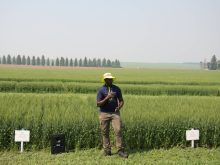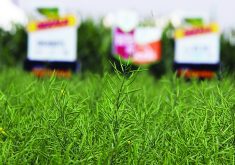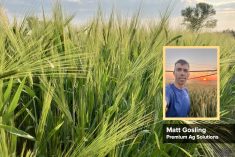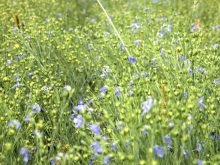Farm and agriculture leaders are urging farmers not to panic about the discovery of a dangerous new canola disease in Manitoba.
However, farmers should spend the winter learning all about verticillium wilt: how to spot it and how to prevent it spreading.
With only one known field infected, there is a chance it can still be eradicated.
“We’ve got it quarantined, isolated,” said Ed Rempel, president of the Manitoba Canola Growers Association.
Canola Council of Canada president Patti Miller said eradication might be possible.
Read Also

Huge Black Sea flax crop to provide stiff competition
Russia and Kazakhstan harvested huge flax crops and will be providing stiff competition in China and the EU.
“If this is a completely isolated incident, maybe there is something that can be done,” she said.
“If there are other locations, you would look at other risk mitigation factors.”
Verticillium wilt, which is the No. 1 canola disease in Sweden, was spotted in one field at harvest time, with patches of crop showing a strange wilting pattern. Manitoba Agriculture and Canadian Food Inspection Agency officials visited the field, took samples, organized quarantine measures and chased down the identity of the pathogen.
It was verified a few weeks ago as verticillium wilt, a brassica disease so far not found in any North American oilseed crops.
It is not the same verticillium that affects crops such as sunflowers, alfalfa and potatoes, but it does affect other brassica plants.
The disease becomes evident near crop maturity and damages crop yields, causing significant losses based on the degree of field infection.
Manitoba Agriculture crop management specialist Holly Derksen said verticillium wilt can appear to be similar to fusarium wilt and blackleg, but has differences that can reveal its true nature.
The disease appears as a long brown or grey lesion on the green stem, like fusarium wilt, and leaves “black peppering” of sclerotia on the plant. However, verticillium’s spots appear underneath the dried outer skin of the plant rather than on top of it like blackleg.
For more information on how to identify verticillium wilt, visit the Canola Council of Canada or Manitoba Agriculture websites.
The CFIA will be overseeing a prairie-wide farmer survey this spring to see if other cases are appearing. Rempel, who does not know the location of the field or the identity of the farmer, wants farmers to co-operate with control efforts and for reporting to remain voluntary.
“Manitoba canola growers do not want triple-S: shoot, shovel and shut up,” said Rempel.
“We need our 9,000 members’ co-operation in this.”
Miller said the canola council’s agronomy experts will be working to understand, spot and control the disease.
“The important thing to understand is now that it’s here, to understand if it’s in other locations and how it spreads,” said Miller.
“It’s been found in one location, it’s contained and we have a lot of experts working together right now to figure out what needs to be done next, what the best risk mitigation strategies are and how we go forward from here.”
The best thing farmers can probably do during winter when the disease is dormant is learn about the disease and think about how to lower their risk, experts said.
The disease is soil-borne, like clubroot, so it’s vital to focus on stopping the transportation of soil from one field to another. If farmers find a suspicious disease, they should contact a provincial crop advisor.
Doubling down on good agronomic practices is the best long-term risk control, Miller added.
“Canola-snow-canola is not a rotation.”


















